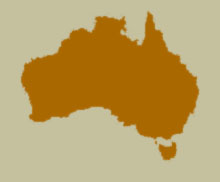Synonyms
Trichorcus cinctus Blackburn, 1892: 73.
Diagnosis
THE SPECIES PAGES ARE UNDER CONSTRUCTION.
HOWEVER, YOU CAN SILL USE THE GENUS AND TRIBE LINKS TO GET FULLY DEVELOPED INFORMATION ON THE GENUS AND TRIBE FOR THIS SPECIES.
TO ACCESS A LIST OF SPECIES THAT ARE FULLY DEVELOPED GO TO LIST OF DEVELOPED SPECIES
Description
Length 3.9 mm. Male. Surface brownish. Pronotum yellowish on anterior angles and across anterior margin. Body hemispherical, densely covered by silky yellowish pubescence. Head somewhat flat between eyes; polished between punctures; punctation about as large as eye facets, very dense and relatively deep, nearly 1/2 diameters apart. Clypeus weakly emarginate; slightly reflexed laterally. Eyes dorsally separated by slightly less than 2 times the width of an eye; inner ocular margin nearly parallel. Antennomeres 3-8 transverse, gradually increasing in width; 9th 2 times longer than 8th; 10th very long, as long as 7th, 8th and 9th combined. Clypeus weakly emarginate; slightly reflexed laterally. Terminal maxillary palpomere subsecuriform, moderately expanded toward apex; apex strongly oblique with outer side about 2 times longer than inner; terminal labial palpomere broad, somewhat barrel-shaped, as long as penultimate segment. Pronotal surface polished between punctures; punctation smaller than eye facets, approximately 2 to 3 diameters apart, getting deeper and more concentrated on anterior angles; lateral borders truncate. Elytral surface coriaceous; the punctation stronger than on pronotum, slightly deeper and more concentrated, about as large as eye facets, larger on lateral margin; lateral margin not reflexed. Abdomen with ventrite 6 fairly visible, conspicuously emarginate.
Male
Tegmen very long, about as long as abdomen length; penis guide symmetrical; distinctly longer than parameres; parameres densely setose at apex, the setae long; strut short, about 1/2 the tegmen length; penis as figured.
Female
Unknown.
Variation
Unknown.
 Distribution and Biology
Distribution and Biology
It was bred by Koebele from pupae found on Moreton Bay Fig (Ficus macrophylla), who considered it to be a coccid feeder. Blackburn recorded the locality as "near Sydney", Koebele as "on the Clarence River, New South Wales".
Species References
Blackburn, T. 1892. Further notes on Australian Coleoptera, with descriptions of new genera and species. XI. Transactions of the Royal Society of South Australia, 15: 20-73.
Slipinski, S.A. 2007. Australian Ladybird Beetles (Coleoptera: Coccinellidae) their biology and classification. ABRS, Canberra. 286 pp.
Slipinski, A. and Giorgi, J.A. 2006. Revision of the Australian Coccinellidae (Coccinellidae). Part 6. Tribe Chilocorini. Annales Zoologici (Warszawa), 56(2): 265-304.
[ Top ]
